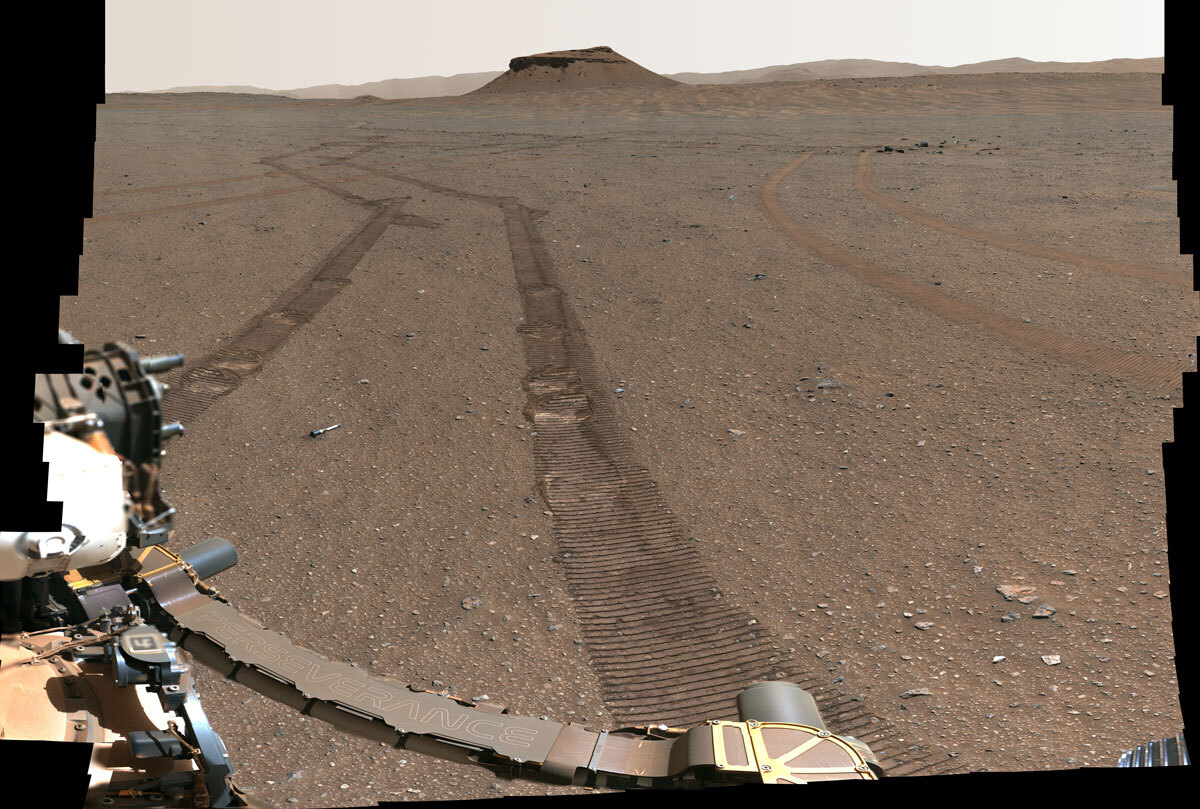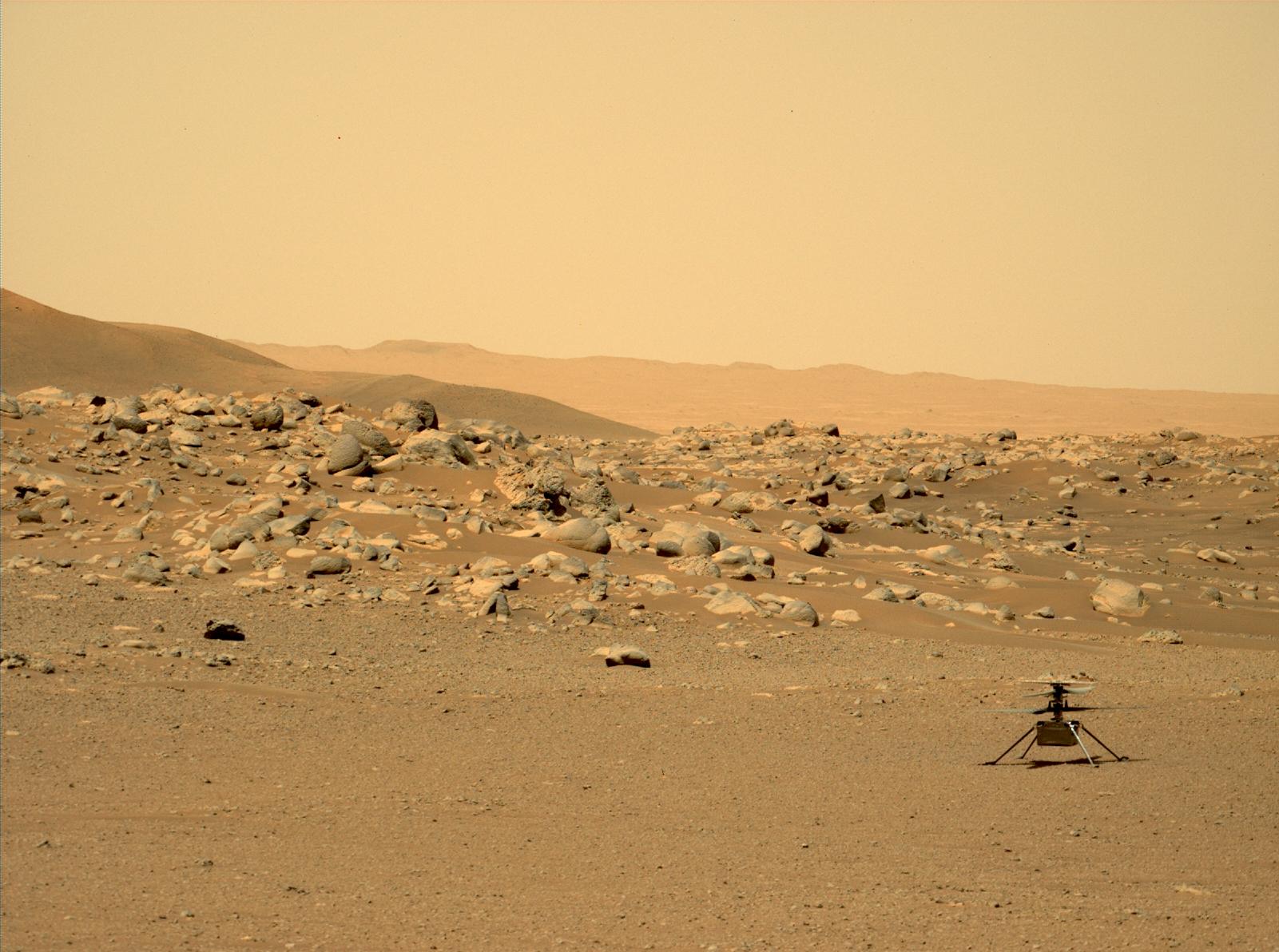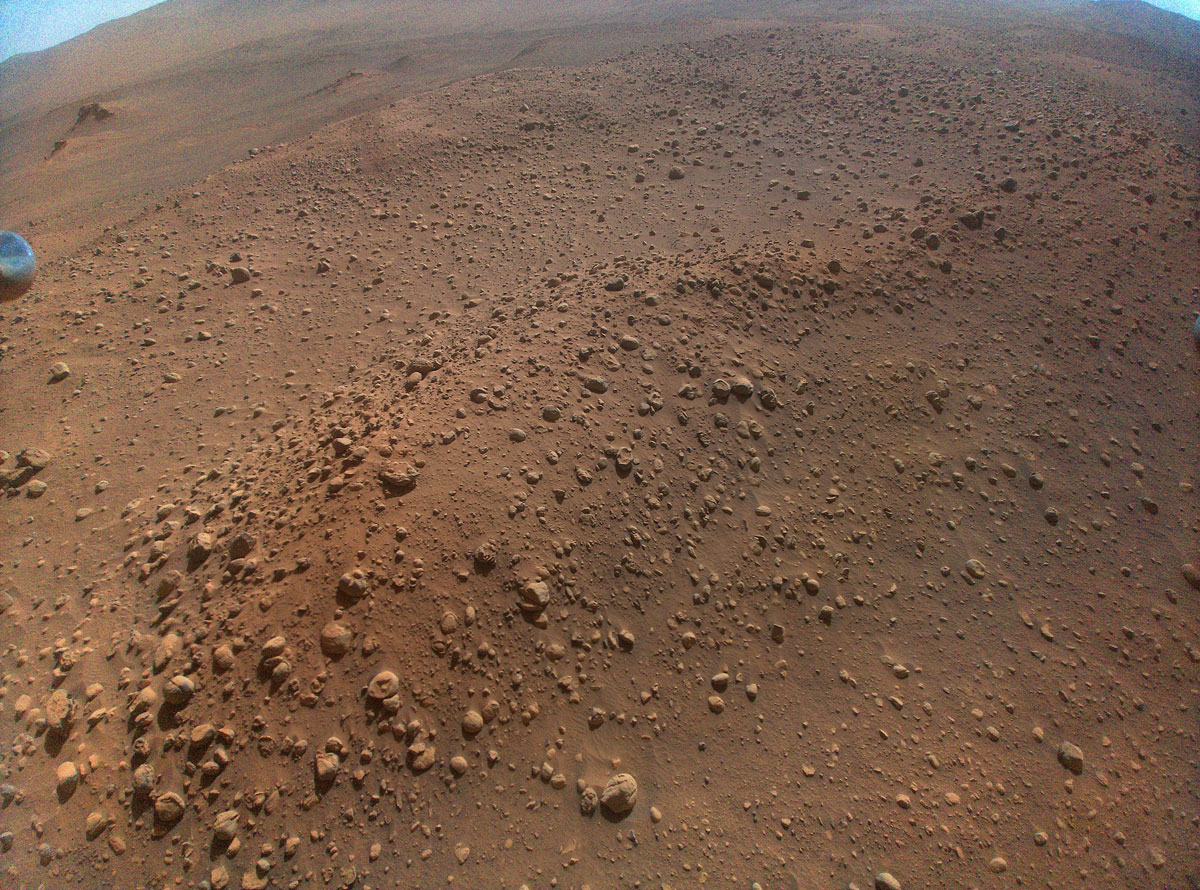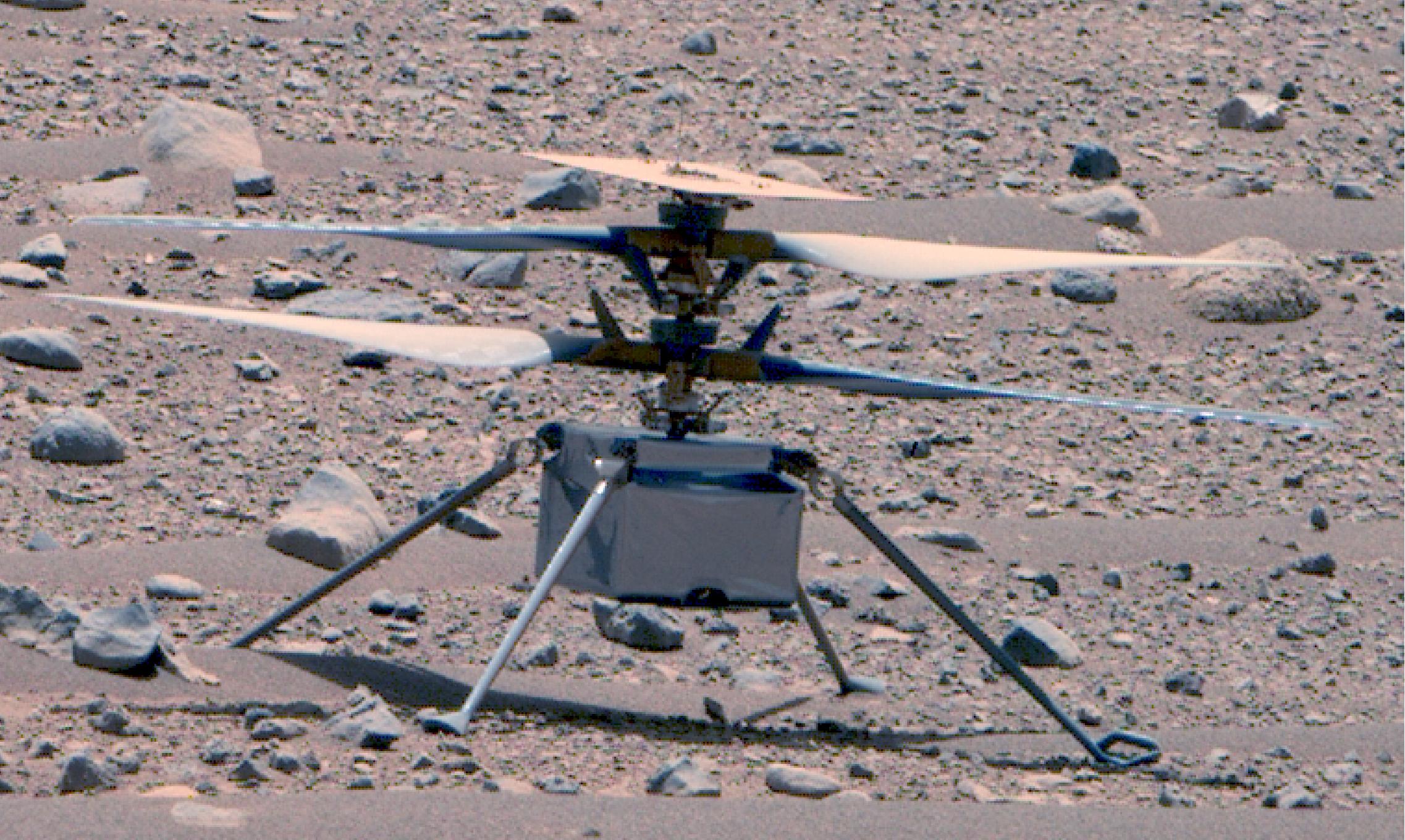- Joined
- 21 January 2015
- Messages
- 12,156
- Reaction score
- 16,372
See Mars Helicopter Ingenuity’s first flight of 2023 in time-lapse + stats:
View: https://youtu.be/OwqTw97nrwI
See Mars Helicopter Ingenuity’s first flight of 2023 in time-lapse + stats:
View: https://youtu.be/OwqTw97nrwI
#MarsHelicopter keeps exploring the Martian skies!
Ingenuity recently completed Flight 39. The rotorcraft stayed aloft for about 79 seconds, traveling 460 feet (140.25 meters) at an altitude of 33 feet (10 meters) and returning to its original take-off location.
The full set, in one view! Check out my new panorama, featuring all of the sample tubes I recently set down as a backup for #MarsSampleReturn.
Trouble spotting them all? Improve your odds with this interactive viewer, and zoom in on the full image:

Ingenuity has completed Flight 43 – its longest flight in nearly a year!
The #MarsHelicopter traveled 1,280 ft (390 m) across the Martian surface for 145.99 seconds at a max. altitude of 40 ft (12 m). https://go.nasa.gov/2U43zuH
We haven't seen photographs of Ingenuity, the little helicopter on #Mars for so long and then she pops up twice in a week.
This is the pick of them, taken by @NASAPersevere rover on March 4th. Some light processing applied:
Ingenuity has completed Flight 47!
The #MarsHelicopter traveled 1,443 ft (440 m) across the Martian surface for 146 seconds at a max. altitude of 40 ft (12 m). https://go.nasa.gov/2U43zuH
Perseverance rover sees Mars helicopter takeoff and mid-air maneuver:
View: https://youtu.be/BjbMe2GEMxU
View: https://twitter.com/nasajpl/status/1635342226598563840
Ingenuity has completed Flight 47!
The #MarsHelicopter traveled 1,443 ft (440 m) across the Martian surface for 146 seconds at a max. altitude of 40 ft (12 m). https://go.nasa.gov/2U43zuH
The #MarsHelicopter is preparing for Flight 50!
Ingenuity is expected to take off no earlier than April 5. It’s set to fly more than 1,000 ft (~306 meters) for 138 seconds. https://go.nasa.gov/4121NaJ
This planned flight will position Ingenuity on the opposite side of a ridgeline from @NASAPersevere, which may hamper communication and delay confirmation of a successful flight. It will, however, keep #MarsHelicopter ahead of the rover as it embarks on its new science campaign.
Exceeding expectations... times 10!
The #MarsHelicopter, a tech demo originally expected to fly only 5 times, has completed its 50th flight on Mars.
So what's ahead for Ingenuity?

NASA’s Ingenuity Mars Helicopter Completes 50th Flight
April 13, 2023
The history-making rotorcraft has recently been negotiating some of the most hazardous terrain it’s encountered on the Red Planet.
NASA’s Ingenuity Mars Helicopter has completed its 50th flight on Mars. The first aircraft on another world reached the half-century mark on April 13, traveling over 1,057.09 feet (322.2 meters) in 145.7 seconds. The helicopter also achieved a new altitude record of 59 feet (18 meters) before alighting near the half-mile-wide (800-meter-wide) “Belva Crater.”
With Flight 50 in the mission logbook, the helicopter team plans to perform another repositioning flight before exploring the “Fall River Pass” region of Jezero Crater.
“Just as the Wright brothers continued their experiments well after that momentous day at Kitty Hawk in 1903, the Ingenuity team continues to pursue and learn from the flight operations of the first aircraft on another world,” said Lori Glaze, director of the Planetary Science Division at NASA Headquarters in Washington.
Ingenuity landed on the Red Planet in February 2021 attached to the belly of NASA’s Mars Perseverance rover and will soon mark the two-year anniversary of its first flight, which took place on April 19, 2021. Designed as a technology demonstration that would fly no more than five times, the helicopter was intended to prove powered, controlled flight on another planet was possible. But Ingenuity exceeded expectations and transitioned into being an operations demonstration.
Every time Ingenuity goes airborne, it covers new ground and offers a perspective no previous planetary mission could achieve. Imagery from the helicopter has not only demonstrated how aircraft could serve as forward scouts for future planetary expeditions, but it has even come in handy for the Perseverance team.
By testing the helicopter’s limits, engineers are gathering flight data that can be used by engineers working on designs for possible future Mars helicopters. That includes the people designing the Mars Sample Return campaign’s proposed Sample Recovery Helicopters.
Riskier Terrain
Since leaving the relatively flat confines of Jezero Crater’s floor on Jan. 19, Ingenuity has flown 11 times, setting new speed and altitude records of 14.5 mph (6.5 meters per second) and 59 feet (18 meters) along the way.
Although the deep chill of winter and regional dust events (which can block the Sun’s rays from reaching the helicopter’s solar panel) have abated, Ingenuity continues to brown out at night. As a result, the Helicopter Base Station on the rover needs to search for the rotorcraft’s signal each morning at the time Ingenuity is predicted to wake up. And when the helicopter does fly, it now must navigate rugged and relatively uncharted terrain, landing in spots that can be surrounded by hazards.
“We are not in Martian Kansas anymore,” said Josh Anderson, Ingenuity operations lead at NASA’s Jet Propulsion Laboratory in Southern California. “We’re flying over the dried-up remnants of an ancient river that is filled with sand dunes, boulders, and rocks, and surrounded by hills that could have us for lunch. And while we recently upgraded the navigation software onboard to help determine safe airfields, every flight is still a white-knuckler.”
Frequent Flyer
Beyond facing more challenging terrain, Ingenuity will also fly at a greater frequency in the coming days because the helicopter needs to remain within electronic earshot of the rover. With its AutoNav capability, Perseverance can travel hundreds of meters each day.
“Ingenuity relies on Perseverance to act as a communications relay between it and mission controllers here at JPL,” said Anderson. “If the rover gets too far ahead or disappears behind a hill, we could lose communications. The rover team has a job to do and a schedule to keep. So it’s imperative Ingenuity keeps up and is in the lead whenever possible.”
Perseverance recently completed exploring “Foel Drygarn,” a scientific target that may contain hydrated silica (which is of strong astrobiological interest). It is currently headed to “Mount Julian,” which will provide a panoramic view into nearby Belva Crater.
Feats of Ingenuity
Built with many off-the-shelf components, such as smartphone processors and cameras, Ingenuity is now 23 Earth months and 45 flights beyond its expected lifetime. The rotorcraft has flown for over 89 minutes and more than 7.1 miles (11.6 kilometers).
“When we first flew, we thought we would be incredibly lucky to eke out five flights,” said Teddy Tzanetos, Ingenuity team lead at JPL. “We have exceeded our expected cumulative flight time since our technology demonstration wrapped by 1,250% and expected distance flown by 2,214%.”
Surpassing expectations like this comes at a cost, however. With some helicopter components showing signs of wear and the terrain becoming more challenging, the Ingenuity team recognizes that every great mission must eventually come to an end. “We have come so far, and we want to go farther,” said Tzanetos. “But we have known since the very beginning our time at Mars was limited, and every operational day is a blessing. Whether Ingenuity’s mission ends tomorrow, next week, or months from now is something no one can predict at present. What I can predict is that when it does, we’ll have one heck of a party.”
More About Ingenuity
The Ingenuity Mars Helicopter was built by JPL, which also manages the project for NASA Headquarters. It is supported by NASA’s Science Mission Directorate. NASA’s Ames Research Center in California’s Silicon Valley and NASA’s Langley Research Center in Hampton, Virginia, provided significant flight performance analysis and technical assistance during Ingenuity’s development. AeroVironment Inc., Qualcomm, and SolAero also provided design assistance and major vehicle components. Lockheed Space designed and manufactured the Mars Helicopter Delivery System.
At NASA Headquarters, Dave Lavery is the program executive for the Ingenuity Mars Helicopter.
New images from @NASAPersevere may show evidence of what was once a wild and deep river on Mars. The observations are leading scientists to rethink how ancient water once flowed on the Red Planet.


Ever since the Perseverance Rover landed on the Martian surface more than two years ago, Ingenuity has been consistently flying. Despite a mission goal around one month long, the helicopter surpassed these expectations and has been continuing to help gather new information and scout for the rover. This was up until a few months ago when NASA lost contact with it.
Specifically, Ingenuity attempted its 52nd flight back on April 26th and while NASA knew the helicopter had flown as instructed, they lost contact with it as it descended. Since then, the agency hadn’t heard a thing and wasn’t sure about the condition of the helicopter. We now know that Ingenuity is in good health and will attempt another flight soon.
This is good news as Perseverance could benefit heavily from more scouting as it makes its way toward new terrain. Here I will go more in-depth into what caused the two month long communication blackout, some of the issues the helicopter has run into, what to expect in the coming months, and more.
Full article here - https://thespacebucket.com/nasa-just-...
With NASA’s future plans of landing humans on Mars and transporting them to and from the planet, one of the most important challenges is the lack of air. There is less than 1% of air on Mars as there is on Earth, and carbon dioxide makes up about 96% of it on Mars. While not ideal, this does present an opportunity to turn that CO2 into oxygen.
A few years ago when the Perseverance Rover landed on the Martian surface, it not only began its main purpose related to sample collection but also creating oxygen. It does this using MOXIE, the Mars Oxygen In-Situ Resource Utilization Experiment. Just recently, researchers pushed MOXIE to a maximum production level — a factor of two higher than reached earlier.
This was able to produce a substantial amount of oxygen compared to previous tests. With this, the agency is more confident in what the future holds as they continue to develop this technology. Here I will go more in-depth into this new milestone, the MOXIE payload, what to expect in the coming months, and more.
Full article here - https://thespacebucket.com/nasas-mars...
"Contact was re-established June 28 when Perseverance crested the hill and could see Ingenuity again."
“The portion of Jezero Crater the rover and helicopter are currently exploring has a lot of rugged terrain, which makes communications dropouts more likely,” said JPL’s Josh Anderson, the Ingenuity team lead. “The team’s goal is to keep Ingenuity ahead of Perseverance, which occasionally involves temporarily pushing beyond communication limits. We’re excited to be back in communications range with Ingenuity and receive confirmation of Flight 52.”
Sixty-three days is a long time to wait for the results of a flight, but the data coming in indicates all is well with the first aircraft on another world. If the remainder of Ingenuity’s health checks are equally rosy, the helicopter may fly again within the next couple of weeks."

NEW PHOTO OF THE MARS HELICOPTER JUST DROPPED
Two more flights in the logbook for Ingenuity! The #MarsHelicopter recently completed Flights 53 and 54.
53: Traveled about 468 feet (143m) for 1 minute and 15 seconds.
54: Spent 24.4 seconds in the air at a height of 16 feet (5m).
Learn more: https://mars.nasa.gov/technology/helicopter/index.cfm?fl=desc
After experiencing an off-nominal scenario during Flight 53, the #MarsHelicopter worked as planned to execute an immediate safe landing. Shortly after, Ingenuity went on to complete Flight 54 with no issues, even spotting its buddy @NASAPersevere.

Ingenuity has now successfully flown on Mars 55 times!
On its latest flight, the #MarsHelicopter flew 866 feet (264 m) for 143 seconds at a height of 32.8 feet (10 m). http://go.nasa.gov/3OIDIT3
After around 2 and a half years on the surface of Mars, the Ingenuity helicopter has just reached a new milestone. Days ago it completed its 57th flight contributing to a total lifetime flight time of over 100 minutes. This came after a few scares in the prior months when Ingenuity was not responding and forced into a low-power mode.
At this point, Ingenuity has surpassed its expected mission lifetime not by months but by years. This is a very big deal considering this mission isn’t a one-off, but supports NASA’s upcoming plans to send an additional two helicopters to the Martian surface. The recent milestone only supports NASA’s plan and the design of these more powerful rotorcraft.
The continued operation of Ingenuity has also helped keep the Perseverance rover on track which is still in close proximity. All this being said, the helicopter has a challenging journey ahead with more flights scheduled and complex terrain in the area. Here I will go more in-depth into Ingenuity’s recent milestone, its current condition, NASA’s new Mars helicopters, and more.
Full article here - https://thespacebucket.com/ingenuity-...
Ingenuity has done it again!
The #MarsHelicopter successfully completed Flight 58 this week, traveling 174 meters at an altitude of 10 meters. The rotorcraft was in the air for 107 seconds. View the stats in the flight log: https://mars.nasa.gov/technology/helicopter/
Ingenuity has set a new record!
The #MarsHelicopter successfully completed Flight 59, flying its highest altitude yet – 20 meters. The rotorcraft was in the air for 142.59 seconds. View the stats in the flight log: https://go.nasa.gov/2U43zuH
60 flights – and another new record!
Ingenuity completed is Flight 60, breaking a groundspeed record by hitting ~17.9 mph (8 m/s). The mighty #MarsHelicopter covered 1,116 ft (340 m) in 133 seconds at an altitude of 53 ft (16 m). https://go.nasa.gov/2U43zuH
